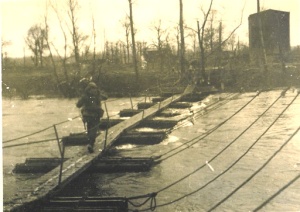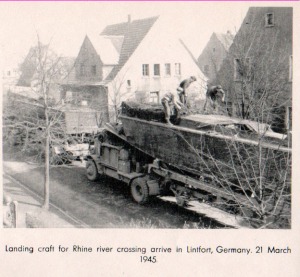By the end of January 1945 the Allies had fought their way back to the positions they occupied before the Battle of the Bulge. Six weeks of fighting in the worst winter many had ever seen where the weather was as much of an enemy as the Germans. The 30th Division assembled near Liernieux, just west of St. Vith, Belgium, where they had been sent to recover from both the cold and the battle casualties. Rumors abounded about what would come next. Would they tackle the Sigfried Line again? Or was something else in store?
After months of fighting the 30th had become a well-oiled fighting machine. Experienced officers and non-coms knew how to plan an attack and how to carry it out. With replacements coming up they knew how to train and quickly assimilate them in with the more experienced soldiers. So it was no surprise when they were reassigned to the Ninth Army and trucked north to take part in clearing out the section of the Rhine valley facing the industrial center in the Ruhr valley.
Returning to the Aachen area and the flat lands of the Cologne plain, Old Hickory received a tough assignment – a treacherous stretch of the Roer River between Julich and Duren, due west from Cologne. The Germans flooded the river by blowing up the control sluices on one of the dams upstream so the Roer crossing, originally planned for February 10, was delayed. Knee deep water covered the lowlands on either bank of the Roer. Like the previous fall when Old Hickory sat facing the Sigfreid Line for two weeks, now they faced the Roer waiting for it to subside. They again used the time for training the men, for reconnaissance and planning. But this time the attack would be across a river rather than against the pillboxes of the Siegfried line.
When they left the Ardennes, the 30th Division along with the entire Ninth Army traveled in secret. They removed shoulder patches and vehicular markings. They assigned code names to roads and telephone exchanges. All to keep the Germans from knowing the Allies exact plans. Although Axis Sally spoke of the 30th returning to the Aachen area, the tactic worked. For once the Germans lost track of Old Hickory.
 Waiting for the river to subside didn’t mean the division was without casualties. German artillery pounded the western bank and the Luffwaffe flew regular missions including the first sightings by 30th Division men of German jet-propelled aircraft. Edward C. Arn, in his memoir “Arn’s War,” tells of being wounded by artillery fire while reconnoitering one of his platoon’s positions near the Roer.
Waiting for the river to subside didn’t mean the division was without casualties. German artillery pounded the western bank and the Luffwaffe flew regular missions including the first sightings by 30th Division men of German jet-propelled aircraft. Edward C. Arn, in his memoir “Arn’s War,” tells of being wounded by artillery fire while reconnoitering one of his platoon’s positions near the Roer.
Before the 30th finally crossed the Roer on February 23, 1945, the biggest artillery barrage in Europe up to that date pounded the Germans on the Eastern shore. The 30th’s assigned 8,000 yards of front received fire from the Division Artillery, plus three 18-piece battalions of 2nd Armored Division’s self-propelled artillery, the 823rd Tank Destroyer’s 36 guns and guns from Corp and Army battalions totaling 246 guns firing. Wow!
While part of the 234th Engineer Combat Battalion ferried men across in Alligators, armored amphibious vehicles, and in assault boats, other engineers struggled to build a footbridge across the Roer, all under the cover of a smoke screen provided by the 82nd Smoke Generator Company. On the far shore the 30th faced little resistance, thanks to the artillery, and quickly accomplished their assigned tasks.
Meanwhile the intrepid engineers completed a treadway bridge in just twenty-one and a half hours allowing tanks and trucks to cross the river. In the next few days Old Hickory took town after town as they moved ever closer to the greatest obstacle between the Allies and the heart of Germany – the Rhine River.
 On March 6, 1945, the 30th Division returned to Maas, Netherlands, to prepare for their next assignment – spearheading the Ninth Army’s attack across the Rhine. Again preparation made all the difference.
On March 6, 1945, the 30th Division returned to Maas, Netherlands, to prepare for their next assignment – spearheading the Ninth Army’s attack across the Rhine. Again preparation made all the difference.
It was March 24, 1944, when all three regiments of the 30th crossed the great river at the same time along a five mile stretch from south of Wesel to Mehrum. Naval assault boats ferried, tanks, tank destroyers and infantry men continuously across the great river. That’s right – the U.S. Navy hauled boats inland for this vital operation. 
Engineers constructed a pontoon bridge for the tanks and other vehicles in record time again under cover of a smoke screen.
The 117th history says the First Battalion of that regiment went first with the Third Battalion carrying the stormboats to the river’s edge so the assault troops would be fresh. It was 2:00 AM on March 24th. With little resistance by midnight the 117th had reached their assigned positions and moved on toward the next town.
For the first few hours after the crossing Old Hickory encountered only light German resistance. Then the 116th Panzer Division moved into their path. One of only two German mobile divisions available, the 116th focused on holding back the 30th while the 15th Panzer Grenadier Division spread out facing the British and Canadians further north. The enemy’s backhanded compliment to the 30th Division wasn’t appreciated by the men on the line.
The 30th doggedly fought their way eastward against armor and anti-aircraft guns lowered to fire at ground troops. After days of continuous fighting fatigue added to the stubborn enemy resistance to slow down Old Hickory. Plans for the 8th Armored Division to pass through the 30th and take on the fight called for the 30th to advance far enough to allow the armor to take over in open country. Old Hickory’s boys fought on taking Gahlen in street fighting against determined resistance. Finally on the morning of March 28, 1945, the 8th Armored Division came forward and took over the fight. Nearly 100 hours after their assault across the Rhine, Old Hickory finally got some much needed rest.
The 30th Division wasn’t through fighting. It would be over a month before Germany finally surrendered. Even at this late date, more would die before the war was over.
I am reading Roer Rhine Ruhr right now as it tells the story of my uncle who died during the battle of the bulge. I would lover to hear more about this and your connection. I am on facebook as JoAnn Thomas Collins if you would like to contact me there.
I am researching my Father Charles C. Wilson who was at most of the notable battles of ww2. What i am finding is the the 187th Combat Engineers Battalion has not Got Any Formal Recognition. I have read a letter from George Patton Jr. Praising his unit, but history has not recognized them. Seems very Disturbing to me